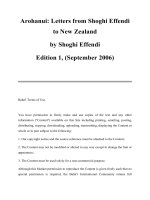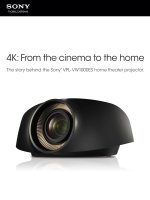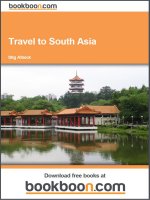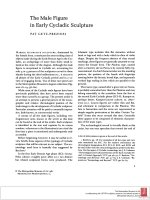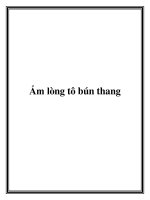FROM PUBLIC FIGURES TO PUBLIC SCULPTURE pot
Bạn đang xem bản rút gọn của tài liệu. Xem và tải ngay bản đầy đủ của tài liệu tại đây (291.2 KB, 9 trang )
For the first time a selection of
maquettes and models of sculptures in
central Melbourne, from the collection
of the City of Melbourne, plus works
sourced from private collections and
various institutions, are on display in
the City Gallery. The exhibits make
clear the emphasis on monuments and
memorials during the 19
th
and early
20
th
centuries and the emergence of
abstract public sculpture in the late
20
th
century. Relevant books,
catalogues, newspaper articles and
statements by the artists on display
give added information and touch on
some of the controversies.
The exhibition catalogue contains a
simple map as a guide for those who,
having seen the artist’s drawings or
maquettes, wish to see the final work
in situ.
Front Cover
Digital collage of
Burke and Wills by
Charles Summers
and Vault by Ron
Robertson–Swann
Loretta Quinn
Beyond the Ocean
of Existence, 1993
bronze on granite
plinth
This exhibition of maquettes, models
and artist’s drawings acts as a potted
history of public sculpture in the
central area of Melbourne. It enables
the visitor to view the sculptor’s initial
ideas and compare with the finished
sculpture, particularly if they sally
forth, map in hand to inspect the work
in situ. The time range is from 1860 to
the present, from Burke and Wills to
Vault and on to the present.
Looking back 150 years we have
reassessed the Burke and Wills 1860
expedition from Melbourne to the Gulf
of Carpentaria. There is no doubting
their fortitude and bravery, but their
unwillingness to relate to the local
Indigenous people meant that Burke
and Wills died of starvation in an
environment that provided adequate
food for the Aborigines. John King
was accepted by the Yandruwandha
people, lived with them and survived.
The people of Melbourne in the 1860s,
however, viewed the expedition quite
differently: they saw the explorers as
national heroes whose exploits and
tragic death should be remembered
with a public monument.
The sculptor Charles Summers rose
to the occasion with a larger than life-
sized depiction of Burke and Wills
which, astonishingly, he cast himself
in a foundry he built at the top of
Collins Street. The sculptor exhibited
his knowledge of classical sculpture,
for the seated figure of Wills has
links with Michelangelo’s Giuliano De
Medici and the noble head of Burke has
a resemblance to the bearded Moses.
The monument was commissioned in
December1863 and unveiled in 1865 in
the presence of an estimated 10,000
people.
While Burke and Wills was certainly
Melbourne’s first public monument*,
from the end of the 19
th
century
the city’s streets and parks became
thickly populated with a plethora
of bronze statues of civic leaders,
politicians, military personnel, kings
and queens. Statues of the great public
benefactor, Sir Redmond Barry and of
Francis Ormond, the founder of the
Workingmen’s College (now elevated
to the Royal Melbourne Institute of
Technology University) were both
unveiled in 1887. But the public were as
SCULPTURE IN THE CITY
KEN SCARLETT
Deborah Halpern
Angel, 1987-89
steel armature,
painted ceramic tiles
on ferro-cement
In the collection of
the National Gallery
of Victoria
keen to see cast in bronze a figure who
had never visited Australian shores: the
leader of Britain’s expansionist designs
on the Sudan in Africa, General Gordon,
was placed on a remarkably tall plinth
in 1889. The degree of popular public
support for monuments and memorials
can be judged by the attendance of the
vast crowd at the unveiling of Burke
and Wills and by the fact that 100,000
citizens subscribed towards the cost of
the General Gordon Memorial – it was,
in fact, over subscribed.
The Age newspaper instituted a
popular one-shilling subscription fund
after the death of Queen Victoria,
which led to a commission for James
White. One might have thought that
this sentiment for memorials would
fade with the death of Queen Victoria,
whose elaborate and extravagant
monument was unveiled in 1907, but
nothing could be further from the
truth. In the 1920s and 30s there were
a series of commissions – King Edward
V11, 1920, the explorer Matthew
Flinders in 1923, the preacher, John
Wesley, 1935 - while recent statues
of Governor La Trobe, placed outside
the State Library of Victoria and
the series of popular personalities
at Docklands, including Dame Edna
Everage, all by Peter Corlett, suggest
that there is still a lingering demand
for physical representation. No longer
linking back to classical sculpture,
however, Corlett’s figures, instead,
have a heightened realism and a direct,
popular appeal.
A dramatic change occurred in 1980
when Ron Robertson-Swann’s Vault
was unveiled on the newly completed
City Square designed by Denton Corker
Marshall. The architects had seen
the sculpture as a focal point on the
square, but ill-informed councillors
began a campaign of vilification, which
was taken up by the press. Commonly
called the Yellow Peril, critics linked
racial prejudice and anti-communist
attitudes as a means of belittling the
work. In spite of strong protests, the
sculpture was ignominiously banished to
a seldom-frequented patch of parkland
beside the Yarra and only recently re-
instated outside ACCA (Australian
Centre for Contemporary Art)
The furore over this abstract sculpture
made architects, developers and
landscape architects very wary
and probably severely limited the
commissioning of public sculpture in
Melbourne for several years. Slowly,
but inevitably, however, attitudes were
changing and by the late 1980s sculptors
such as Akio Makigawa, Anthony
Pryor and Peter Corlett were installing
works in relation to office blocks and
new apartments. By the time of the
Southbank development on the southern
side of the Yarra, begun in 1982 and
completed in 1993, the policy of 1% for
art had been accepted. In a nice reversal
of earlier attitudes, it was the City of
Melbourne that led a revival of public
sculpture within the central business
district with the Swanston Walk project.
A series of commissions were instituted,
including such innovative works as
Architectural Fragment, 1992, by Petrus
Spronk or Simon Perry’s light-hearted
Public Purse, 1994. While there were
some admirable sculptures, the standard
varied, including works such as Three
Simon Perry
Public Purse,
1994
red granite,
stainless steel
James White
Queen Victoria
Memorial, 1904-07
Carrara marble,
granite
to create Birrarung Wilam, the park’s
complex major art work: patterns that
may have been drawn in the earth are
now translated into a pattern that
snakes across the riverside path,
wooden shields are displayed in bronze
and hand-held message sticks appear
as towering wooden posts, a group
of engraved boulders provide visual
and cultural ballast and stories are
told through touch-activated audio
panels. Birrarung Wilam has become
a symbolic link between the past and
the present, between the Indigenous
peoples and those of us who arrived
much more recently.
Times have indeed changed.
Ken Scarlett
Curator
*Charles Summers also did the larger than
life figure in the River God Fountain, now in
the Fitzroy Gardens, which he produced in
association with Clement Hodgkinson in 1862.
Businessmen Who Brought Their Own
Lunch: Batman, Swanston and Hoddle,
which has become all-too popular as a
place for tourists to be photographed.
By the time of the huge Docklands
development, which occurred a few
years later, it was assumed that public
sculpture was
an integral part
of the planning;
Docklands
probably has more
contemporary
sculpture per
building than any
where else in
Australia.
Melbourne has become all the richer with
the placing of public sculpture within
our every-day environment: the public
have grown to accept contemporary
sculpture, to accept the challenges
of often extremely diverse styles of
expression. While we can justifiably claim
to be the cultural capital of Australia, we
haven’t recently managed to attract a
crowd of 10,000 to an unveiling as the
Burke and Wills Monument did in 1865.
Our growing maturity and
sophistication, nevertheless, was
clearly illustrated when Melbourne’s
first Asian-born Lord Mayor John
So, spoke at the ‘unveiling’ of Vault,
moved to its third location in 2002,
on the site beside ACCA. No longer
ridiculed it was now ‘welcomed like an
old and respected
friend into a new
home. Times have
changed’ said the
Lord Mayor.
This evolution
of public and
official attitudes
was further
demonstrated
with the establishment of Birrarung
Mar beside the Yarra. Remembering
that the land of the Wurundjeri
and Boonwerrung peoples was
appropriated to build the city of
Melbourne, it was symbolic that
the City Council established this
new parkland to commemorate and
celebrate their connection to the
land. Vicki Couzens, Lee Darroch and
Treahna Hamm were commissioned
IT wAS THE CITY
of MELboURNE THAT
LEd A REvIvAL of PUbLIC
SCULPTURE wITHIN
THE CENTRAL bUSINESS
dISTRICT wITH THE
SwANSToN wALK PRojECT.
Ron Robertson-
Swann
Vault, 1978-80
painted steel
06
SWANSTON ST
RUSSELL ST
QUEEN ST
ELIZABETH ST
LATROBE ST
A BECKETT ST
FRANKLIN ST
DUDLEY ST
VICTORIA ST
LONSDALE ST
LT LONSDALE ST
LT BOURKE ST
BOURKE ST
LT COLLINS ST
COLLINS ST
FLINDERS ST
FLINDERS LN
B
A
E
D
C
F
IJ
OR
L
M
Q
R
S
P NO
K
G
U
T
H
CITY of MELboURNE
SCULPTURE wALK
START
The sculptures are listed alphabetically,
starting with works south of the Yarra River
and going north along Swanston Street and
returning via Elizabeth Street. See list on
pages 12 & 13 for artwork details.
No1 Tram to
Vault at ACCA
Town Hall
Victoria
Market
Birrarung
Marr
Yarra River
L. Edward Ginger
Born Sri Lanka 1951,
arrived in Australia 1975
The Echo, 1997
fabricated steel,
polyurethane paint
450 x 200 x 190 cm
M. Bronwyn Snow
Born in Cairns in 1962
Resting Place, 1994
steel and jarrah
300 x 260 x 100 cm
N. James Gilbert/
Percival Ball.
James Gilbert was active in
Melbourne in the 1890s. Percival
Ball was born in England in 1845,
arriving in Australia 1885, but left
in 1899. Died in 1900
Sir Redmond Barry, 1880-1887
begun by Gilbert in the
early1880s, completed
by Ball 1886-7
bronze, over life-size
figure on pedestal
In the collection of the
State Library of Victoria
O. Petrus Spronk.
Born Haarlem, The Netherlands,
arrived in Australia 1957
Architectural Fragment,
1992-93
basalt and gold-leaf lettering
2.5 x 7 x 5 m
P. Peter Corlett
Born 1944 in Melbourne
Governor La Trobe, 2006
bronze
Plinth 50 x 50 x 50.5 cm
Sculpture 235 x 64 x 55 cm
In the collection of the
State Library of Victoria
Q. John Simpson Mackennal
Born 1832 near Stranraer,
Ayrshire, Scotland, arrived
in Australia in 1852 or 1854.
Died in 1901
Cow, Bull and Sheep, 1884
painted cement
Located within the semi-circular
arch at entrance to Meat and
Fish Hall, Queen Victoria Market.
There are also two rams heads
on either side
R. Pauline Fraser
Born in 1953 on Christmas Island
Wind Contrivance, 1994-95
bronze, redgum, Harcourt granite
274 x 150 x 65cms
S. Mark Stoner
Born London 1951,
arrived in Australia 1956
Passage, 1993
basalt
Main element 300 x 210 x 137
cms plus three separate blocks
(Originally there were four
blocks)
T. Simon Perry
Born in the United Kingdom in
1962, arriving in Australia in 1992
The Public Purse, 1994
Calca red granite
and stainless steel
65 x 200 x 140 cm
U. Tom Bass
Born in 1916 in Lithgow,
New South Wales, died
in Sydney in 2010
The Children’s Tree, 1962-3
bronze
Currently owned by Challenger
Managed Investments Ltd.
Take No 1 Tram on Swanston
Street to ACCA
Ron Robertson-Swann,
Born Sydney in 1941
Vault, 1978-80
painted steel
6.15 x 11.84 x 10.3 m
Installed on City Square 1980,
removed and installed at
Batman Park 1981, relocated
to ACCA (Australian Centre for
Contemporary Art) Southbank
2002
All sculptures are in the City
of Melbourne Art and Heritage
collection, unless otherwise
stated.
A. James White.
Born Edinburgh, Scotland in
1862, arrived in Australia 1884,
died in Brisbane in 1918
Queen Victoria Memorial,
1904-07,
Carrara marble, granite
total height 10.5 m
Includes four figures
representing Progress, History,
Wisdom and Justice. Queen
Victoria carries orb and sceptre.
Located at Queen Victoria
Gardens.
B. Tom Bass.
Born in 1916 in Lithgow,
New South Wales, died
in Sydney in 2010
The Genie, 1973
bronze,
185 x 180 x 175 cm
Located at Queen Victoria
Gardens.
C. Konstantin Dimopolous.
Born 1954 in Egypt, moved to
New Zealand in 1963 and then
settled in Melbourne in 2003
Red Centre, 2006
high performance
composite, concrete
Height 7 m, base 2.5 x 2.3 m
In the collection of
Federation Square
D. Vicki Couzens, Lee Darroch
and Treahna Hamm
Birrarung Wilam, 2006
stone, wood, stainless
steel, bronze, nickel and
audio installation
Consists of mound campsite,
eel pathway, two message sticks,
five shields, ancestor stones,
interpretive panels, water vessels
and an audio installation
Located at Birrarung Marr
E. Deborah Halpern,
Born 1957 in Melbourne
Angel, 1987-89
steel armature, painted
ceramic tiles on ferro-cement
924.5 x 992.5 x 351.5 cm
Originally installed in the
moat of the NGV, relocated
to Birrarung Marr in 2006
In the collection of the
National Gallery of Victoria
F. Charles Web Gilbert
Born at Cockatoo, near
Talbot in 1867, died 1925
Captain Matthew Flinders
Memorial, 1923-25
bronze on granite base
approx 390 x 160 x 230 cm
G. Loretta Quinn
Born Hobart in 1956
Beyond the Ocean
of Existence, 1993
bronze on granite plinth
550 x 270 x 200 cm
H. Pamela Irving
Born 1960 in Melbourne
Larry Latrobe, 1996
bronze
(original version of 1993
was stolen in August 1995)
34.2 x 39 x 21 cm
I. Charles Summers
Born 1825 at East Charlton,
Somerset, England. Arrived
in Australia 1853 and left in
1867. Died in Paris 1878,
buried in Rome
Burke and Wills Memorial,
1865
bronze on granite base
standing figure 390 cm,
base 460 cm
J. Akio Makigawa
Born in 1948 in Japan,
arrived in Western Australia
in 1974. Died Melbourne 1999
Time and Tide, 1993-4
basalt, carrara white marble,
bronze, cast and fabricated
stainless steel, cast concrete
with fibre optics and white
gold-leaf
800 x 500 x 2500 cm
K. Paul Quinn
and Alison Weaver
Both artists born in 1962
Three Business Men Who
Brought Their Lunch: Batman,
Swanston and Hoddle, 1993-94
bronze
Each figure 2m high
SCULPTURES oN THE
CITY of MELboURNE
SCULPTURE wALK
Exhibition dates
03.02.11 – 16.04.11
Gallery hours
Monday 10am – 2pm
Tues to Fri 11am – 6pm
Saturday 11am – 4pm
City Gallery
Melbourne Town Hall
Swanston Street
(enter via halftix)
Our thanks to all the artists who have
enriched our city with their sculpture
and to the numerous sculptors, private
collectors, galleries and institutions
who have made models, maquettes
and ephemera available for display.
This exhibition has only been made
possible with the dedicated support of
the staff of Art and Heritage Collection,
City of Melbourne, particularly Eddie
Butler-Bowdon and Catherine Hockey,
who have worked with the curator, Ken
Scarlett, to co-ordinate the display
and the organization of the catalogue,
which was so skillfully designed by the
staff of Round, Rhys Gorgol and Robert
Nudds. The assistance of Erin Reeve with
publicity was invaluable. Special thanks
to Dr John Denton, the guest speaker at
the official opening of the exhibition.
ACKNowLEdGEMENTS
Rear Cover
Digital collage of
Captain Matthew
Flinders Memorial by
Charles Web Gilbert
and Architectural
Fragment by Petrus
Spronk.
SCULPTURAL MAQUETTES
ANd ModELS IN THE
EXHIbITIoN
1. Tom Bass
Maquette for The
Children’s Tree, 1962-3,
bronze
23.5 x 18 x 19 cm
Edition of 15
On loan from the
Tom Bass Studio School
2. Fionna Clarke
and Ken McKean
Maquette for Eel Trap, 2006
painted and engraved steel
55 x 47.5 x 10.5cm
City of Melbourne Art
and Heritage Collection
3. Peter Corlett
Maquette for Governor
La Trobe, 2006
bronze
40 x 15 x 15 cm
On loan from John Drury,
Honorary Secretary, the
C.J.La Trobe Society
4. Edward Ginger
Maquette for The Echo, 1997
painted aluminium
56 x 25.5 x 24.5 cm
City of Melbourne Art
and Heritage Collection
5. Deborah Halpern
Maquette for Angel, 1987
steel, wire mesh
84.5 x 25.5 x 66 cm
On loan from the artist
6. Deborah Halpern
Maquette for Angel, 1987
earthenware
16.5 x 12 x 16 cm
On loan from the artist
7. Pamela Irving
Maquette for Larry Latrobe,
1992
painted ceramic
65 x 60 x 23 cm
On loan from the artist
8. Akio Makigawa
Maquette for Time and Tide,
1993-4
Carrara white marble, basalt
46 x 47 x 30 cm
On loan from Carlier Makigawa
9. Akio Makigawa
Maquette for Time and Tide,
1993-4
painted balsa wood
28 x 42 x 28 cm
On loan from Carlier Makigawa
10. Simon Perry
Maquette for Public Purse,
1994
plaster of Paris
12 x 21 x 20 cm
City of Melbourne Art
and Heritage Collection
11. Loretta Quinn
Maquette for Beyond the
Ocean of Existence, 1993
bronze
38 x 21 x 25 cm
City of Melbourne Art
and Heritage Collection
12. Ron Robertson-Swann
Model of Vault, 1979
painted steel
49.5 x 115.5 x 59.5 cm
Edition of 10
City of Melbourne Art
and Heritage Collection
Donated by Dr Joseph Brown
13. Ron Robertson-Swann
Model of Vault, 2000
painted aluminium
31 x 65 x 24 cm
Edition of 10
On loan from John Fasham,
J.K.Fasham Pty. Ltd
14. Bronwyn Snow
Maquette for Resting Place,
1994
wood and metal
44 x 55 x 35.5 cm
City of Melbourne Art
and Heritage Collection
15. Petrus Spronk
Maquette for Architectural
Fragment, 1992
painted balsa wood
23 x 81 x 56.3 cm
City of Melbourne Art
and Heritage Collection
16. Mark Stoner
Maquette for Passage, 1994
painted concrete
Main element
30.5 x 21 x 18 cm
Three separate blocks
4 x 14.4 x 6 cm
4.9 x 11.4 x 5.1 cm
5 x 10.5 x 6.5 cm
City of Melbourne Art
and Heritage Collection
17. Charles Summers
Maquette for Burke and Wills,
1865
painted plaster of Paris
118 x 70 x 54.2 cm
On loan from Warnambool
Art Gallery
18. Charles Summers
Maquette for Burke and Wills,
1865
painted plaster of Paris
72 x 35 x 30cm
On loan from the Royal
Society of Victoria

